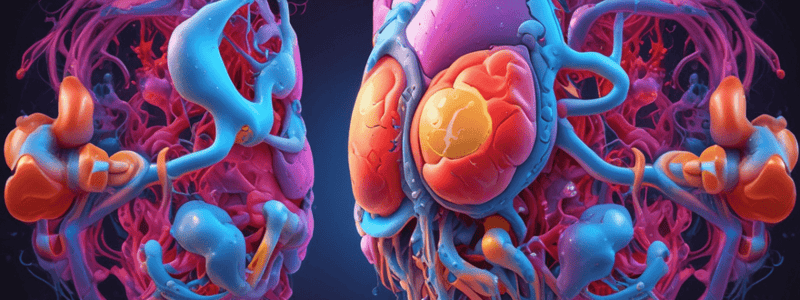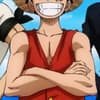Podcast
Questions and Answers
What is a common characteristic of hormones that helps them affect only target cells?
What is a common characteristic of hormones that helps them affect only target cells?
- They are catabolized by circulating enzymes
- They are excreted directly by the kidneys
- They circulate in free, unbound forms
- They operate within feedback systems (correct)
Which type of hormone is primarily circulating bound to a carrier?
Which type of hormone is primarily circulating bound to a carrier?
- Testosterone
- Peptides like insulin
- Tyrosine and thyroxine from the thyroids (correct)
- Catecholamines from the adrenal medulla
What is the most common way hormonal secretion is maintained within a physiologic range?
What is the most common way hormonal secretion is maintained within a physiologic range?
- Neural control
- Positive feedback systems
- Negative feedback systems (correct)
- Endocrine regulation by chemical factors
What is the general effect of lack of negative feedback inhibition on hormonal release?
What is the general effect of lack of negative feedback inhibition on hormonal release?
Which hormone type circulates in free, unbound forms and has a short-acting response?
Which hormone type circulates in free, unbound forms and has a short-acting response?
What is the main characteristic of target cells in relation to hormone sensitivity?
What is the main characteristic of target cells in relation to hormone sensitivity?
What is the main function of Adrenocorticotropic hormone (ACTH) released by the anterior pituitary?
What is the main function of Adrenocorticotropic hormone (ACTH) released by the anterior pituitary?
Which hormone released by the anterior pituitary promotes secretion of melanin?
Which hormone released by the anterior pituitary promotes secretion of melanin?
What is the target organ of Thyroid-stimulating hormone (TSH) released by the anterior pituitary?
What is the target organ of Thyroid-stimulating hormone (TSH) released by the anterior pituitary?
Which neurotransmitter directly affects the regulation of anterior pituitary hormones?
Which neurotransmitter directly affects the regulation of anterior pituitary hormones?
What inhibits the secretion of growth hormone from the anterior pituitary?
What inhibits the secretion of growth hormone from the anterior pituitary?
Which target organs are affected by Growth hormone (GH) released by the anterior pituitary?
Which target organs are affected by Growth hormone (GH) released by the anterior pituitary?
What is the function of Prolactin-inhibiting factor (PIF)?
What is the function of Prolactin-inhibiting factor (PIF)?
Which hormone is responsible for the release of TSH (Thyroid-Stimulating Hormone)?
Which hormone is responsible for the release of TSH (Thyroid-Stimulating Hormone)?
What is the primary function of Corticotropin-releasing hormone (CRH)?
What is the primary function of Corticotropin-releasing hormone (CRH)?
Which hormone inhibits the release of both Growth Hormone (GH) and Thyroid-Stimulating Hormone (TSH)?
Which hormone inhibits the release of both Growth Hormone (GH) and Thyroid-Stimulating Hormone (TSH)?
What is the primary role of Antidiuretic Hormone (ADH) in the body?
What is the primary role of Antidiuretic Hormone (ADH) in the body?
Which hormone is responsible for causing uterine contractions and milk ejection in lactating women?
Which hormone is responsible for causing uterine contractions and milk ejection in lactating women?
What is the function of Prolactin in women?
What is the function of Prolactin in women?
Which cells do Luteinizing hormone (LH) target in men?
Which cells do Luteinizing hormone (LH) target in men?
What is the role of Thyroid hormone (TH) Triiodothyronine (T3) in the body?
What is the role of Thyroid hormone (TH) Triiodothyronine (T3) in the body?
Which gland secretes calcitonin to lower serum calcium levels?
Which gland secretes calcitonin to lower serum calcium levels?
What hormonal imbalance results in hyperthyroidism?
What hormonal imbalance results in hyperthyroidism?
What is the primary function of Parathyroid hormone (PTH)?
What is the primary function of Parathyroid hormone (PTH)?
Which hormone promotes the synthesis of proteins, lipids, and nucleic acids?
Which hormone promotes the synthesis of proteins, lipids, and nucleic acids?
What stimulates the alpha cells of the pancreas to release glucagon?
What stimulates the alpha cells of the pancreas to release glucagon?
Which type of cells secrete somatostatin and gastrin in the pancreas?
Which type of cells secrete somatostatin and gastrin in the pancreas?
What is the role of insulin in controlling blood glucose levels?
What is the role of insulin in controlling blood glucose levels?
Which factor diminishes the secretion of insulin?
Which factor diminishes the secretion of insulin?
What inhibits glycogenolysis, gluconeogenesis, and ketogenesis in the liver?
What inhibits glycogenolysis, gluconeogenesis, and ketogenesis in the liver?
Study Notes
Anterior Pituitary Hormones
- 7 major stimulatory hormones released by the anterior pituitary:
- Adrenocorticotropic hormone (ACTH): targets adrenal cortex, increases steroidogenesis (cortisol and androgenic hormones)
- Melanocyte-stimulating hormone (MSH): targets pigment cells, promotes melanin secretion and lipotropin
- Thyroid-stimulating hormone (TSH): targets thyroid, increases thyroid hormone production and iodine uptake
- Growth hormone (GH): targets muscle, bone, and liver, essential for normal tissue growth and maturation
Hormone Characteristics
- Specific rates and rhythms of secretion
- Operate within feedback systems (positive or negative) to maintain optimal internal environment
- Affect only target cells with appropriate receptors, initiating specific cell functions or activities
- Excreted directly by the kidneys or deactivated by the liver for renal excretion
Hormone Types
- Steroids: cortisol from adrenal cortex, estrogen, progesterone from ovaries, testosterone from testes
- Amino acids: tyrosine and thyroxine from thyroids, catecholamines from adrenal medulla
- Proteins: peptides like insulin from pancreas
Hormone Regulation
- Chemical factors (blood sugar or calcium levels)
- Endocrine factors (hormone from one endocrine gland controlling another)
- Neural control
- Negative feedback is the most common type, maintaining hormonal secretion within a physiologic range
Hormone Circulation
- Water-soluble hormones (insulin, pituitary, hypothalamic, parathyroid, norepinephrine, and epinephrine) circulate in free, unbound forms, with short-acting response and catabolized by circulating enzymes
- Lipid-soluble hormones (cortisol, adrenal androgens, aldosterone, estrogens/progesterone, testosterone) circulate bound to a carrier protein, with rapid and long-lasting response
Target Cells
- Recognize and bind with high affinity to hormones, initiating a signal
- Up-regulation: low concentrations of hormones increase the number of receptors per cell
- Down-regulation: high concentrations of hormones decrease the number of receptors
Hypothalamus
- Connected to anterior pituitary by portal blood vessels
- Connected to posterior pituitary by a nerve tract (supraopticohypophsial tract)
- Produces hormones: PIF (dopamine), TRH, GnRH, somatostatin, GRF, CRH, and Substance P
Posterior Pituitary Hormones
- Antidiuretic hormone (ADH, arginine vasopressin): controls plasma osmolality, causes water reabsorption in kidneys
- Oxytocin: causes uterine contractions and milk ejection, serves as co-factor with vitamin D to increase calcium absorption
Endocrine Pancreas
- Produces hormones glucagon and insulin
- Houses the islets of Langerhans, with different cell types secreting various hormones:
- Alpha cells: secrete glucagon
- Beta cells: secrete insulin and amylin
- Delta cells: secrete somatostatin and gastrin
- F cells: secrete pancreatic polypeptide
Insulin
- Synthesized from proinsulin in beta cells
- Anabolic hormone, promotes synthesis of proteins, lipids, and nucleic acids
- Facilitates glucose uptake into cells, controlling blood glucose levels
- Regulated by chemical, hormonal, and neural control
- Secretion promoted by increased blood glucose levels, amino acids, and parasympathetic stimulation
- Secretion diminishes with low blood glucose levels, high insulin levels, and sympathetic stimulation
Other Hormones
- Prolactin: targets breast, functions in milk production, with effects on reproductive and immune functions
- Luteinizing hormone (LH): targets granulosa cells in women, Leydig cells in men, functions in ovulation, progesterone production, testicular growth, and testosterone production
- Follicle-stimulating hormone (FSH): targets granulosa cells in women, Sertoli cells in men, functions in follicle maturation, estrogen production, and spermatogenesis
Studying That Suits You
Use AI to generate personalized quizzes and flashcards to suit your learning preferences.
Related Documents
Description
Explore the characteristics of hormones in endocrine physiology, including autocrine, paracrine, and endocrine signaling. Learn about the specific rates of secretion, feedback systems, target cells, and the effects of hormones on cell functions.





